HOW HOUSTON SCAVENGERS STAYED OUT OF GUTTERS AND DITCHES BACK THEN 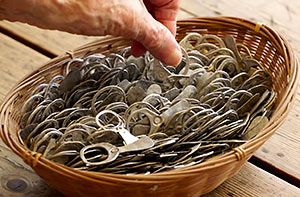 Embedded in a profile of 99-year-old artist Elinor Evans, who taught freshman design at the university in the sixties, seventies, and eighties — and whose exhibition of collages at the Moody Gallery opened earlier this month — is this bit of old-fashioned Houston street smarts: “She retrieved another basket and displayed a most orderly collection of hundreds of aluminum pull-tabs. Decades ago, Houston’s streets sloped inward and the centers provided ripe pickings for Evans, who said she surveyed them for ‘as found’ objects of interest.” [Rice News; exhibition] Still image: Rice News
Embedded in a profile of 99-year-old artist Elinor Evans, who taught freshman design at the university in the sixties, seventies, and eighties — and whose exhibition of collages at the Moody Gallery opened earlier this month — is this bit of old-fashioned Houston street smarts: “She retrieved another basket and displayed a most orderly collection of hundreds of aluminum pull-tabs. Decades ago, Houston’s streets sloped inward and the centers provided ripe pickings for Evans, who said she surveyed them for ‘as found’ objects of interest.” [Rice News; exhibition] Still image: Rice News
Tag: Houston History
BUILDING THE BIGGEST LIVING ROOM IN THE WORLD 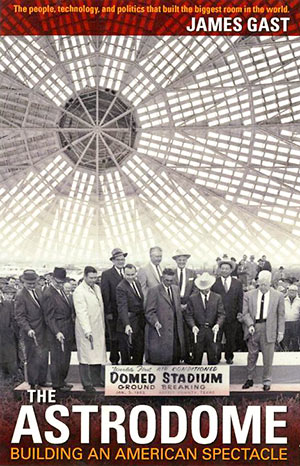 From the prologue to The Astrodome: Building a Domed Spectacle, James Gast’s just-published history of the origins of the Harris County Domed Stadium: “The Astrodome is not a distinctive work of architecture. It is certainly not a bad building, nor is it an exceptionally beautiful one. The Astrodome ended its days as a major league venue in 1999, but it remains a uniquely influential building. On the simplest level, it changed the game of baseball and — in the opinion of legions of self-described purists — not for the better. If you happen to be a student of the game, you know that the artificial turf first introduced at the Astrodome changed the way baseball was played, placing a new emphasis on speed and spawning a generation of light-hitting speedsters playing on artificial turf fields with deep fences.
Off the field, the Astrodome’s creature comforts and barrage of electronic media forever changed the way the game is viewed. The Dome rose alongside the growing influence of television, and stood as a response to a commercial threat posed by television. To lure paying customers away from their TV sets and into the ballpark, stadiums needed to deliver comfort and amenities on par with the spectators’ living rooms. The Dome competed with television by emulating it: a comfortable seat, good food, and frequent electronic distractions. If, while at Phoenix’s Chase field, you find yourself engrossed in a video on the 6,200-square—foot high-definition scoreboard while enjoying curried chicken tacos with mint-marinated cucumbers and yogurt on top of scallion pancakes, you can thank — or curse — the Astrodome.” [Astrodome Book]
From the prologue to The Astrodome: Building a Domed Spectacle, James Gast’s just-published history of the origins of the Harris County Domed Stadium: “The Astrodome is not a distinctive work of architecture. It is certainly not a bad building, nor is it an exceptionally beautiful one. The Astrodome ended its days as a major league venue in 1999, but it remains a uniquely influential building. On the simplest level, it changed the game of baseball and — in the opinion of legions of self-described purists — not for the better. If you happen to be a student of the game, you know that the artificial turf first introduced at the Astrodome changed the way baseball was played, placing a new emphasis on speed and spawning a generation of light-hitting speedsters playing on artificial turf fields with deep fences.
Off the field, the Astrodome’s creature comforts and barrage of electronic media forever changed the way the game is viewed. The Dome rose alongside the growing influence of television, and stood as a response to a commercial threat posed by television. To lure paying customers away from their TV sets and into the ballpark, stadiums needed to deliver comfort and amenities on par with the spectators’ living rooms. The Dome competed with television by emulating it: a comfortable seat, good food, and frequent electronic distractions. If, while at Phoenix’s Chase field, you find yourself engrossed in a video on the 6,200-square—foot high-definition scoreboard while enjoying curried chicken tacos with mint-marinated cucumbers and yogurt on top of scallion pancakes, you can thank — or curse — the Astrodome.” [Astrodome Book]
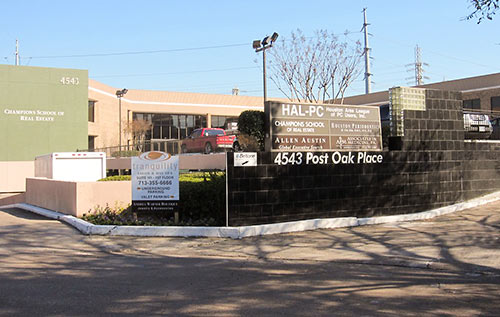
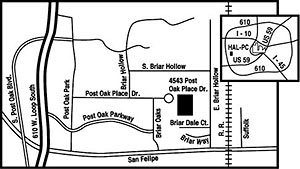 The Houston Area League of PC Users will be moving out of its ghost town of a 6,665 sq. ft. headquarters space in the sleepy 2-story office building at 4543 Post Oak Place Dr. a bit later than its originally announced deadline of the end of 2013. But HAL-PC isn’t leaving (as it declared last year) to find some more suitable space with more attractive rents and fewer parking problems, and so the building can work its way to a new identity as an assembly of medical clinics; it’s leaving on account of the organization is shutting down entirely. By a vote of the board of directors earlier this week, HAL-PC has chosen to disband.
The Houston Area League of PC Users will be moving out of its ghost town of a 6,665 sq. ft. headquarters space in the sleepy 2-story office building at 4543 Post Oak Place Dr. a bit later than its originally announced deadline of the end of 2013. But HAL-PC isn’t leaving (as it declared last year) to find some more suitable space with more attractive rents and fewer parking problems, and so the building can work its way to a new identity as an assembly of medical clinics; it’s leaving on account of the organization is shutting down entirely. By a vote of the board of directors earlier this week, HAL-PC has chosen to disband.
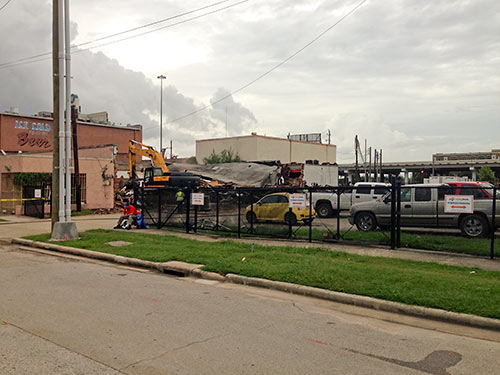
Chiming in with this morning’s Demo Report, which more formally announces the departure of a couple of old single-story buildings at 607 and 609 Chenevert St., reader Jack Miller sends in this photo of the scene yesterday a couple blocks north of the George R. Brown Convention Center and immediately south of Minute Maid Park. At the far left, an excavator is seen assuring that the former Houston Professional Musicians’ Association and Houston Precious Metals buildings from 1949 will indeed get out of the way in time for the Nau Center for Texas Cultural Heritage to be built on the site.
Is this yet another story of older Houston buildings making way for the new? Maybe, but at a larger scale, it’s partly the reverse: Two houses from 1904 and 1905 were moved onto a portion of Avenida de Las Americas glommed onto the site 3 years ago, on a spot across Texas Ave. from the ball park (behind and to the left of the camera). And the photo below includes a glimpse (on the far right) of the 1919 Southern Pacific 982 steam engine scooted out of the houses’ way and settled in along the light-rail line on Capitol St.:
DRESSING UP THE MENIL HOUSE, SCARING THE ARCHITECT AWAY 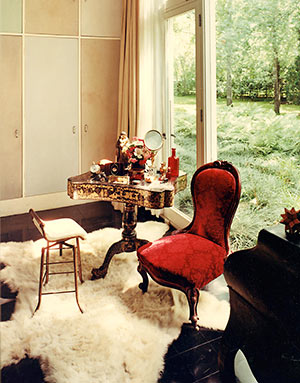 “Philip [Johnson] felt we should have a Mies van der Rohe settee, a Mies van der Rohe glass table and two Mies van der Rohe chairs on a little musty-colored rug,” explained Dominique de Menil about the distinctive yet undeniably Miesian modern home at 3363 San Felipe St. the already-somewhat-famous museum curator-turned-architect had designed for her and her husband. “We wanted something more voluptuous.” And so in 1950 the first family of Schlumberger hired Mr. Voluptuous himself, the dress designer Charles James, to create the new home’s interiors — something he had never done before, and never would do again. How’d that turn out? Here’s Joanna McCutcheon, giving some background to the Menil Collection’s current exhibition featuring clothing and furniture James designed for his patron: “Upon entering the house — a clean, strictly modernist construction of brick, steel and glass, he immediately demanded that the ceilings be raised 10 inches. He wanted additional room to facilitate his plan of coating the walls in lurid felt and velvet. . . . The walls of the Johnson house were swaddled in dyed felts, while dark spaces were illuminated with shocking colour. Horrified, Johnson refused to include the house in his portfolio for decades afterwards.” [Disegno Daily] Photo of Menil House dressing room: Menil Collection
“Philip [Johnson] felt we should have a Mies van der Rohe settee, a Mies van der Rohe glass table and two Mies van der Rohe chairs on a little musty-colored rug,” explained Dominique de Menil about the distinctive yet undeniably Miesian modern home at 3363 San Felipe St. the already-somewhat-famous museum curator-turned-architect had designed for her and her husband. “We wanted something more voluptuous.” And so in 1950 the first family of Schlumberger hired Mr. Voluptuous himself, the dress designer Charles James, to create the new home’s interiors — something he had never done before, and never would do again. How’d that turn out? Here’s Joanna McCutcheon, giving some background to the Menil Collection’s current exhibition featuring clothing and furniture James designed for his patron: “Upon entering the house — a clean, strictly modernist construction of brick, steel and glass, he immediately demanded that the ceilings be raised 10 inches. He wanted additional room to facilitate his plan of coating the walls in lurid felt and velvet. . . . The walls of the Johnson house were swaddled in dyed felts, while dark spaces were illuminated with shocking colour. Horrified, Johnson refused to include the house in his portfolio for decades afterwards.” [Disegno Daily] Photo of Menil House dressing room: Menil Collection
COMMENT OF THE DAY: THE ROOMS IN THE OLD RICE HOTEL HAVE BEEN SHUFFLED AROUND A BIT 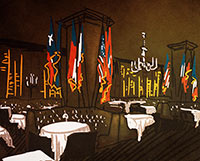 “Jim is absolutely correct. The Old Capitol Club was adjacent to The Flag Room, on the first floor. The Flag Room space is now Sambuca. A little internet sleuthing pulls up a dining room shot of some built in booths surrounding structural columns that now frame the stage at Sambuca.” [Josh, commenting on The Rice Hotel’s Storied State Bar, a Favorite Among Lawyers, Will Soon Turn into a Lawless Kitchen] Illustration: Lulu
“Jim is absolutely correct. The Old Capitol Club was adjacent to The Flag Room, on the first floor. The Flag Room space is now Sambuca. A little internet sleuthing pulls up a dining room shot of some built in booths surrounding structural columns that now frame the stage at Sambuca.” [Josh, commenting on The Rice Hotel’s Storied State Bar, a Favorite Among Lawyers, Will Soon Turn into a Lawless Kitchen] Illustration: Lulu
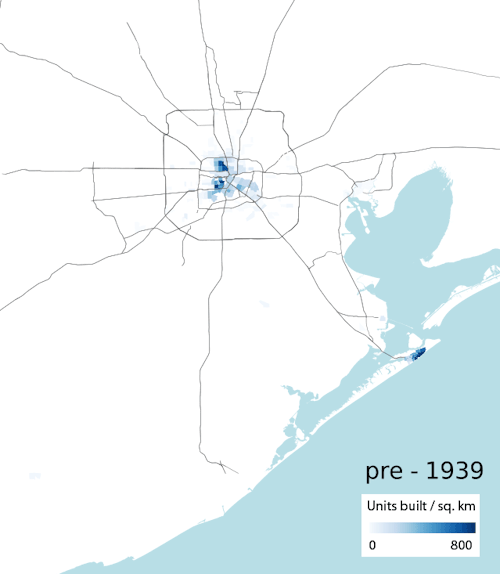
If the Greater Houston Partnership is eager to include some exhibits or animated GIFs to go along with the video footage of cars driving through imaginary barriers, shiny skyscrapers, and smiling people that pepper its new campaign celebrating Houston as The City of No Limits, it might want to look at the work of California computational biologist [and former Houstonian and longtime Swamplot reader] Ian Rees. Using data from the American Community Survey, Rees mapped structures in the region by the decade they were built, grading their concentration with varying shades of blue.  The result helps us visualize the decades-long march of Houston housing ever outward. His map, shown above, was featured in a series of articles on the Next City website on urban sprawl, a few of which compare Houston’s growth to those of other major U.S. cities.
Unfortunately, the data (and the dancing blue construction hotspots) stop in 2010, and we’re left to ourselves to wonder whether Houston is still on track to continue its now-officially-enshrined core mission. An earlier version of Rees’s map breaks out the last recent decade into 2 separate frames, helping to illustrate the scale and sequence of the more recent Inner Loop construction revival:
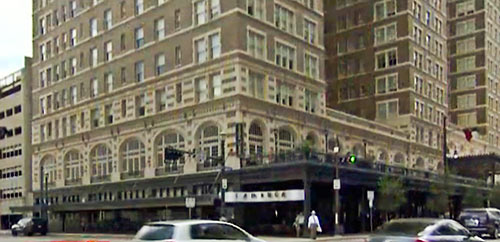
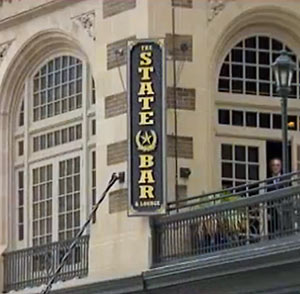 The State Bar and Lounge, which shut down this past weekend after more than 15 years in a storied space that was formerly home to the Capitol Club in the Rice Hotel, is about to undergo a “massive remodel,” a source tells Swamplot.
The State Bar and Lounge, which shut down this past weekend after more than 15 years in a storied space that was formerly home to the Capitol Club in the Rice Hotel, is about to undergo a “massive remodel,” a source tells Swamplot.
The members-only Capitol Club was once the haunt of a number of powerful and well-known attorneys, politicians and other powerful men in the city; according to KHOU’s Doug Miller, it was also the site of President Kennedy’s last drink (unless, of course, he polished off a few more daiquiris in his hotel room after his late-November 1963 visit). In its quasi-reconstruction and rebirth as a public establishment after the renovation of the Rice Hotel into the Rice Lofts in 1998, the spot maintained popularity among lawyers — especially the newly minted ones: Many would head to the State Bar to celebrate passing the state bar.
To judge it by its name, however, the new second-story venue now being planned there may have a slightly different set of guiding principles. A bar named Lawless Kitchen and Spirits will open in the space after renovations are complete, the source tells Swamplot.
COMMENT OF THE DAY: WHEN HELICOPTERS RULED THE HOUSTON SKIES  “Armadillo Airways was the service that flew to IAH from the Galleria, Whitehall Hotel (downtown), Shamrock Hilton and the Westchase Hilton. Flights cost $49 each way. The service was started by the son of the inventor of the Weed Eater.
I remember my dad taking this service from an earlier location in the Globe Department Store parking lot at the SW corner of what is now I-10 & Beltway 8. This all went away with the mid-80′s oil bust. Here is an old pamphlet.” [Holtnow, commenting on A Heliport Lands In Spring Branch East] Illustration: Lulu
“Armadillo Airways was the service that flew to IAH from the Galleria, Whitehall Hotel (downtown), Shamrock Hilton and the Westchase Hilton. Flights cost $49 each way. The service was started by the son of the inventor of the Weed Eater.
I remember my dad taking this service from an earlier location in the Globe Department Store parking lot at the SW corner of what is now I-10 & Beltway 8. This all went away with the mid-80′s oil bust. Here is an old pamphlet.” [Holtnow, commenting on A Heliport Lands In Spring Branch East] Illustration: Lulu
PROTESTORS AT DEMOLISHED SITE OF HISTORIC HOUSTON PROTESTS ENSURE REPLACEMENT STRUCTURE WON’T BE DEMOLISHED 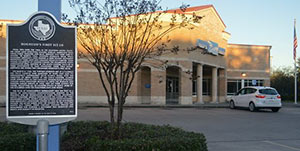 Responding to months of community pressure and protests, postal service officials today reversed course from an earlier announcement and said they will neither close nor move the Southmore Station Post Office. In March of 1960, 13 college students marched from the campus of Texas Southern University to the Weingarten’s Grocery at 4110 Almeda St. to conduct the city’s first sit-in, at the store’s whites-only lunch counter. The nonviolent protests, which lasted for weeks, led to the desegregation of all city lunch counters just a few months later, and steady movement toward the desegregation of all city facilities. The Weingarten’s building was quietly demolished sometime between 1995 and 2002 (judging from aerial photos of the site); the post office was built in its place. A plaque commemorating the sit-in, erected in 2009, stands on the sidewalk in front of the replacement building’s parking lot. The city still has plans to close or relocate the University, Greenbriar, Julius Melcher, Memorial Park, and Medical Center Station facilities, but no final decisions on them have been announced. [The Houston Advocate] Photo: Defender Network
Responding to months of community pressure and protests, postal service officials today reversed course from an earlier announcement and said they will neither close nor move the Southmore Station Post Office. In March of 1960, 13 college students marched from the campus of Texas Southern University to the Weingarten’s Grocery at 4110 Almeda St. to conduct the city’s first sit-in, at the store’s whites-only lunch counter. The nonviolent protests, which lasted for weeks, led to the desegregation of all city lunch counters just a few months later, and steady movement toward the desegregation of all city facilities. The Weingarten’s building was quietly demolished sometime between 1995 and 2002 (judging from aerial photos of the site); the post office was built in its place. A plaque commemorating the sit-in, erected in 2009, stands on the sidewalk in front of the replacement building’s parking lot. The city still has plans to close or relocate the University, Greenbriar, Julius Melcher, Memorial Park, and Medical Center Station facilities, but no final decisions on them have been announced. [The Houston Advocate] Photo: Defender Network
THE SWEET SMELL OF HOUSTON HISTORY 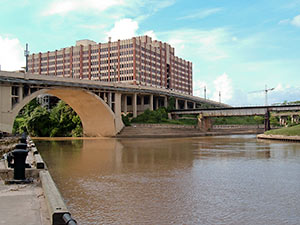 Embarking on a tour of Houston by means of a “site-specific narrative” created by 3 artists as part of the Mitchell Center for the Arts’ first CounterCurrent Festival earlier this month, critic Betsy Huete picks up her “survival pack” of a bottle of water, a Metro day pass, a phone charger, and a bottle of Purell hand sanitizer enclosed in a koozie, and heads to the first stop: Allen’s Landing. There she encounters one of the artists, Lacy M. Johnson: “Johnson suggested I begin reading the essays accompanying The Invisible City, a series of writings tied to specific coordinates within the city of Houston. I would have to read each excerpt at each location to fully understand the work. The writing tied to Allen’s Landing was a brief recalling of Houston’s history, starting with its birth as a settlement at Allen’s Landing and, eventually, a meditation on the city’s rabid desire to erase itself and rebuild, leaving a palimpsest of memory and history. As I descended the stairs overlooking the bayou’s lush greenery on that crisp spring morning, with an erect corporate sky line as backdrop to errant clothes and shards of glass, with the stink of urine-saturated concrete pervading my nostrils, Johnson’s statement could not have rung more true. It was beautiful.” [Glasstire] Photo: Scott Ehardt [license]
Embarking on a tour of Houston by means of a “site-specific narrative” created by 3 artists as part of the Mitchell Center for the Arts’ first CounterCurrent Festival earlier this month, critic Betsy Huete picks up her “survival pack” of a bottle of water, a Metro day pass, a phone charger, and a bottle of Purell hand sanitizer enclosed in a koozie, and heads to the first stop: Allen’s Landing. There she encounters one of the artists, Lacy M. Johnson: “Johnson suggested I begin reading the essays accompanying The Invisible City, a series of writings tied to specific coordinates within the city of Houston. I would have to read each excerpt at each location to fully understand the work. The writing tied to Allen’s Landing was a brief recalling of Houston’s history, starting with its birth as a settlement at Allen’s Landing and, eventually, a meditation on the city’s rabid desire to erase itself and rebuild, leaving a palimpsest of memory and history. As I descended the stairs overlooking the bayou’s lush greenery on that crisp spring morning, with an erect corporate sky line as backdrop to errant clothes and shards of glass, with the stink of urine-saturated concrete pervading my nostrils, Johnson’s statement could not have rung more true. It was beautiful.” [Glasstire] Photo: Scott Ehardt [license]
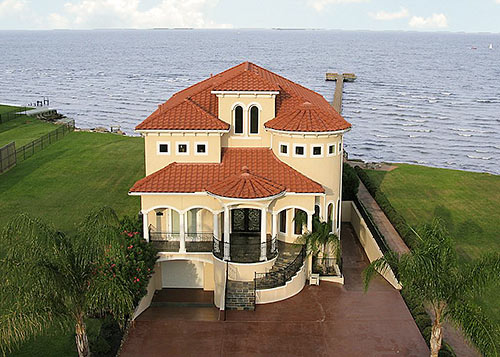
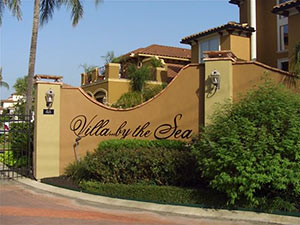 Welcome to lovely Villa by the Sea, the quaint Mediterranean-themed gated McMansion development off Todville Rd. in Seabrook that just happens to be built on the grounds of the former mansion where owner, trailer-rental mogul, and child predator Bill List was shot by some angry houseguests back in 1984. That last detail about the neighborhood’s history, apparently, was unknown to Nir Golan, who recently signed a lease to rent the house pictured above. The 4,550-sq.-ft. seaside home at 514 Villa Dr. was built in 2006 on a section of the land where part of List’s absurd 34,000-sq.-ft. mansion itself once stood, facing east toward Galveston Bay.
Welcome to lovely Villa by the Sea, the quaint Mediterranean-themed gated McMansion development off Todville Rd. in Seabrook that just happens to be built on the grounds of the former mansion where owner, trailer-rental mogul, and child predator Bill List was shot by some angry houseguests back in 1984. That last detail about the neighborhood’s history, apparently, was unknown to Nir Golan, who recently signed a lease to rent the house pictured above. The 4,550-sq.-ft. seaside home at 514 Villa Dr. was built in 2006 on a section of the land where part of List’s absurd 34,000-sq.-ft. mansion itself once stood, facing east toward Galveston Bay.
Golan says his Realtor didn’t tell him about the homesite’s history, but that he simply can’t live there now that he knows what happened. “People say that they wouldn’t come to my house as a guest,” he tells KHOU’s Jacqueline Crea. Crea reports that the homeowner has agreed to terminate Golan’s lease, but won’t return the deposit; he tells her he had no obligation to disclose any information about the Todville mansion. (Law professor Gerald Treece, who appears in the story, seems to agree on the disclosure issue.) Golan plans to sue to the current owner to get his money back, he tells KHOU.
HOW THE BEER CAN HOUSE GOT ITS BEER, AND OTHER ESSENTIAL STORIES OF ENSHRINED HOUSTON WACKINESS  Somebody oughta write a history, you’ve probably thought at some point, of the singular, weird art treasures like the Orange Show, the Beer Can House, the Flower Man‘s house, and okay, maybe Pigdom and TemplO and Notsuoh — that give Houston legitimate license to call itself funky. But it took a relative newcomer — writer Pete Gershon moved to Houston in 2005 — to conduct all the interviews and get these and other stories down on paper. Gershon’s new book, Painting the Town Orange: The Stories Behind Houston’s Visionary Art Environments, weaves together tales of the creation and preservation of these and other unique urban places, giving a detailed view of the thinking (and in at least one instance, drinking) that put them together and drew others to them. Sections on Grace Bashara Green’s stuffed-to-the-gills house at 414 Avondale St., David David Smalley’s Miniature Museum at 1406 Welch, Dolan Smith’s Museum of the Weird, and Bill Davenport’s 11th St. junk shop art studio on 11th St. were cut from the manuscript before it was published, but posted separately on the art blog The Great God Pan Is Dead. [Brazos Bookstore]
Somebody oughta write a history, you’ve probably thought at some point, of the singular, weird art treasures like the Orange Show, the Beer Can House, the Flower Man‘s house, and okay, maybe Pigdom and TemplO and Notsuoh — that give Houston legitimate license to call itself funky. But it took a relative newcomer — writer Pete Gershon moved to Houston in 2005 — to conduct all the interviews and get these and other stories down on paper. Gershon’s new book, Painting the Town Orange: The Stories Behind Houston’s Visionary Art Environments, weaves together tales of the creation and preservation of these and other unique urban places, giving a detailed view of the thinking (and in at least one instance, drinking) that put them together and drew others to them. Sections on Grace Bashara Green’s stuffed-to-the-gills house at 414 Avondale St., David David Smalley’s Miniature Museum at 1406 Welch, Dolan Smith’s Museum of the Weird, and Bill Davenport’s 11th St. junk shop art studio on 11th St. were cut from the manuscript before it was published, but posted separately on the art blog The Great God Pan Is Dead. [Brazos Bookstore]

A funny thing happened on the way to carefully disassembling the former Menil Museum on the campus of Rice University so that it could be rebuilt somewhere in the Fourth Ward with the help of a Brown Foundation grant: After workers spent a week or so carefully removing the corrugated galvanized but weathered panels on the building, an excavator began summarily demolishing the rest yesterday. Or almost the rest — work had to be stopped after crews hit a power line, Molly Glentzer at the Chronicle reports.
So by midday today the scene near Rice University’s University Dr. entrance looked something like this:
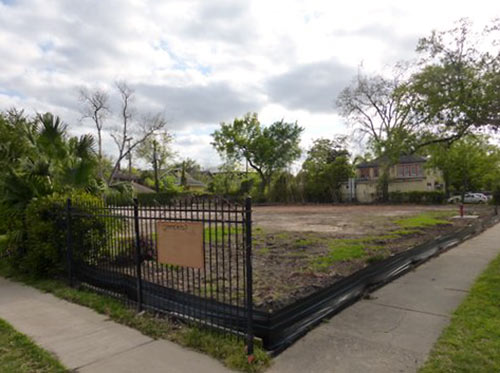
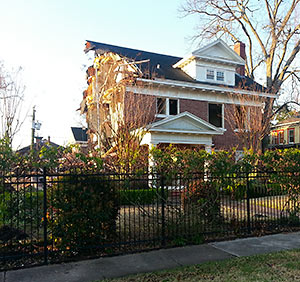 A bulletin board with a request for “comments” went up last week on the fence fronting the now-vacant site at 411 Lovett Blvd. in Avondale, where the 1906 Bullock–City Federation Mansion was torn down earlier this year (see photo at right). Yes, the metal fence along Lovett Blvd. is still standing. Passers-by have been adding their thoughts.
A bulletin board with a request for “comments” went up last week on the fence fronting the now-vacant site at 411 Lovett Blvd. in Avondale, where the 1906 Bullock–City Federation Mansion was torn down earlier this year (see photo at right). Yes, the metal fence along Lovett Blvd. is still standing. Passers-by have been adding their thoughts.

